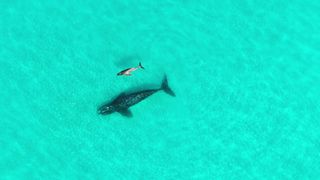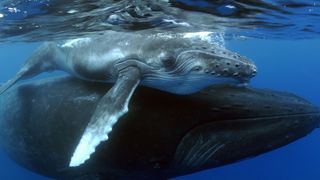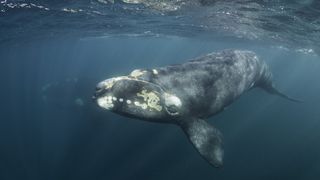Whale sighting in Australia hints at 'extremely unusual' interspecies adoption
An adult southern right whale was recently spotted swimming alongside a humpback whale calf. Experts think the larger whale may have adopted the juvenile after it lost its real mother.

A southern right whale (Eubalaena australis) in Australia has been spotted with a very unusual companion in tow: a juvenile humpback whale (Megaptera novaeangliae). Experts suspect this may be an extremely rare example of interspecies adoption, in which the adult right whale has taken on a surrogate mother role for the unrelated youngster.
Jess Wohling, a photographer based in Esperance in the state of Western Australia, captured drone footage of the unusual pair swimming along the coast off a nearby beach. But it was only when she was reviewing the footage that she realized the calf's species did not match that of the adult it was swimming alongside.
"I was like, 'Surely this can't be right,'" Wohling told Australian news site ABC News. "I got pretty excited."
Wohling sent the footage to Katy Fannei, a researcher with the Australia-based Little White Whale Project, which tracks southern right whales in the area. Fannei was "blown away" by the images. "I've texted everyone I know," Fannei told ABC News. "I'm friends or colleagues with a lot of whale researchers who have way more years of experience than I have, and all of them were really surprised as well."
Related: Newfound whale species that lives exclusively in US waters may already be on the brink of extinction
Fannei thinks the adult right whale may be acting as a surrogate mother to the young humpback, which would make this footage the first evidence that these two species could engage in such a relationship.
"I think it can certainly be the most likely case that it's kind of an adoption," Fannei said. The proximity of the adult and calf as they swim next to each other in the video is almost identical to the closeness exhibited by related mother and calf pairs when they travel together, she added.
Sign up for the Live Science daily newsletter now
Get the world’s most fascinating discoveries delivered straight to your inbox.
Erich Hoyt, a research fellow at Whale and Dolphin Conservation in the U.K. and author of the "Encyclopedia of Whales, Dolphins and Porpoises" (Firefly Books, 2017), told Live Science in an email that this could be an interspecies adoption. It would be "extremely unusual," but it's "not impossible," he said.

Hoyt added that, if this is an adoption, the most likely scenarios are that the humpback calf became separated from its mother or that its mother died before the calf had fully developed. Humpback calves normally stay with their mothers for the first 11 to 12 months of life, Hoyt said, adding that an abandoned calf "could welcome a similar size baleen whale mother for comfort."
It's also possible that the adult right whale is a bereaved female that recently lost her own calf, Hoyt said. If this is the case, she may have heard the distress calls of the juvenile humpback and swum over to aid the youngster, he added. However, it is unclear from the photos if the adult is a female.
Hoyt has seen examples of killer whales (Orcinus orca) engaging in this type of adoption behavior. In these cases, females took in abandoned calves from other pods and brought them into their own group, he said.
However, there may be other explanations, Hoyt said. It could be that the humpback prematurely parted with its mother and might just be seeking out other whales to follow instead, in which case the southern right whale not be not actively playing a nurturing role, he added.

"It will be important to follow the interaction between the two individuals over time and to see if it persists," Hoyt said.
Fannei and her colleagues are currently trying to identify the adult right whale in the footage to see if they can learn more about its parenting history and help researchers pinpoint the pair's possible location, according to ABC News.
Past cetacean adoptions
This is not the first time that cetaceans from two separate species have formed what appears to be an adopted family bond.
In 2018, researchers based near the St. Lawrence River in Quebec, Canada, came across a juvenile narwhal (Monodon monoceros) living among beluga whales (Delphinapterus leucas), according to the Sea Watch Foundation. The young narwhal was around 620 miles (1,000 kilometers) from its Arctic home, and experts think the belugas may have taken in the young narwhal after it lost its way while migrating.
And in 2013, a group of sperm whales (Physeter macrocephalus) in the Azores made headlines after befriending a bottlenose dolphin (Tursiops truncatus) that appeared to have spinal deformities. Experts think it was "adopted" by the massive whales after being abandoned by its own pod. The cetaceans were seen together for only a couple of days, so it is uncertain if the dolphin was able to keep up with the deep-diving sperm whales for long, according to the Sea Watch Foundation.
There also have been reports of bottlenose dolphins adopting abandoned whale calves. In 2014, a dolphin took on a maternal role for a melon-headed whale (Peponocephala electra), caring for the whale calf as well as her own offspring. In 2021, another dolphin in New Zealand took a pilot whale (Globicephala) under its wing (or flipper). However, on this occasion, it appears that the dolphin temporarily lured the young whale away from its real mother, who took back her offspring several months later, the Sea Watch Foundation reported.

Harry is a U.K.-based senior staff writer at Live Science. He studied marine biology at the University of Exeter before training to become a journalist. He covers a wide range of topics including space exploration, planetary science, space weather, climate change, animal behavior, evolution and paleontology. His feature on the upcoming solar maximum was shortlisted in the "top scoop" category at the National Council for the Training of Journalists (NCTJ) Awards for Excellence in 2023.
